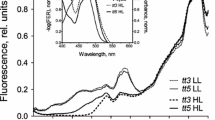Abstract
The red laser-induced chlorophyll-fluorescence induction kinetics of predarkened leaf samples were registered simultaneously in the 690 and 730 nm regions i.e., in the region of the two chlorophyll fluorescence emission maxima. From the induction kinetics the chlorophyll fluorescence ratio F690/F730 was calculated. The ratio F690/F730 shows to be dependent on the chlorophyll content of leaves. It is significantly higher in needles of damaged spruces (values of 0.45–0.9) than in normal green needles of healthy trees (values of 0.35–0.5). During development and greening of maple leaves the ratio F690/F730 decreases with increasing chlorophyll content. Determination of the ratio F690/F730 can be a suitable method of monitoring changes in chlorophyll content in a non-destructive way in the same leaves during development or the yellowish-green discolouration of needles of damaged spruces in the Black Forest with the typical tree decline symptoms.
Similar content being viewed by others
Abbreviations
- F690/F730:
-
ratio of the fluorescence yield at the two fluorescence-emission maxima in the 690 and 730 nm regions
- Fm :
-
maximum fluorescence
- Fs :
-
steady-state fluorescence
References
French CS (1960) The chlorophylls in vivo and in vitro. In: Ruhland W (ed) Handbuch der Pflanzenphysiologie, Vol 5/1, pp 252–297
Haitz M and Lichtenthaler HK (1988) The measurement of Rfd-values as plant vitality indices with the portable field fluorometer and the PAM-fluorometer. In: Lichtenthaler HK (ed) Applications of Chlorophyll Fluorescence, pp 249–254. Dordrecht, Kluwer Academic Publishers
Kautsky H and Franck U (1943) Chlorophyllfluoreszenz und Kohlensäure-assimilation. Biochem Z 315: 139–232
Krause GH and Weis E (1983) Chlorophyll fluorescence as a tool in plant physiology. II. Interpretation of fluorescence signals. Photosynth Res 5: 129–157
Lichtenthaler HK (1987a) Chlorophyll fluorescence signatures of leaves during the autumnal chlorophyll breakdown. J Plant Physiol 131: 101–110
Lichtenthaler HK (1987b) Chlorophylls and carotenoids: pigments of photosynthetic biomembranes. Methods Enzymol 148: 350–382
Lichtenthaler HK and Rinderle U (1988) The role of chlorophyll fluorescence in the detection of stress conditions in plants. CRC Critical Reviews in Analytical Chemistry 19, Suppl I: 29–85
Lichtenthaler HK, Rinderle U and Haitz M (1989) Seasonal Variations in Photosynthetic Activity of Spruces as determined by Chlorophyll Fluorescence. Ann Sci For 46 suppl: 483s-489s
Nagel EM, Buschmann C and Lichtenthaler HK (1987) Photoacoustic spectra of needles as an indicator for the activity of the photosynthetic apparatus of healthy and damaged conifers. Physiol Plant 70: 427–437
Papageorgiou G (1975) Chlorophyll fluorescence: An intrinsic probe of photosynthesis. In: Govindjee (ed) Bioenergetics of Photosynthesis, pp 319–371. New York, Academic Press
Walker DA (1988) Some aspects of the relationship between chlorophyll a fluorescence and photosynthetic assimilation. In: Lichtenthaler HK (ed) Applications of Chlorophyll Fluorescence, pp 13–20. Dordrecht, Kluwer Academic Publishers
Author information
Authors and Affiliations
Rights and permissions
About this article
Cite this article
Lichtenthaler, H.K., Hak, R. & Rinderle, U. The chlorophyll fluorescence ratio F690/F730 in leaves of different chlorophyll content. Photosynth Res 25, 295–298 (1990). https://doi.org/10.1007/BF00033170
Received:
Accepted:
Issue Date:
DOI: https://doi.org/10.1007/BF00033170



